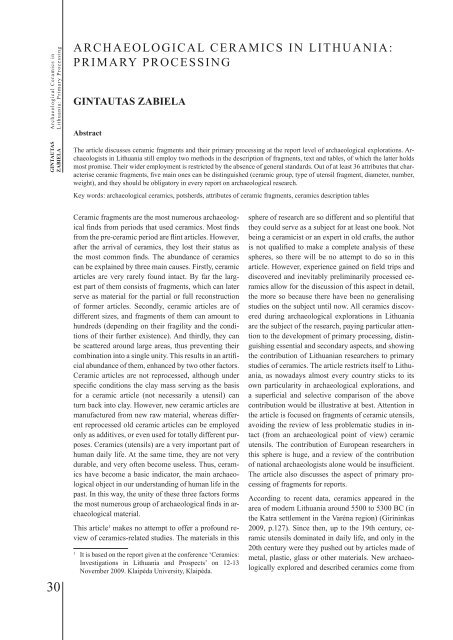BALTICA16 - Klaipėdos universitetas
BALTICA16 - Klaipėdos universitetas
BALTICA16 - Klaipėdos universitetas
You also want an ePaper? Increase the reach of your titles
YUMPU automatically turns print PDFs into web optimized ePapers that Google loves.
Archaeological Ceramics in<br />
Lithuania: Primary Processing<br />
GINTAUTAS<br />
ZABIELA<br />
30<br />
ARCHAEOLOGICAL CERAMICS IN LITHUANIA:<br />
PRIMARY PROCESSING<br />
GINTAUTAS ZABIELA<br />
Abstract<br />
The article discusses ceramic fragments and their primary processing at the report level of archaeological explorations. Archaeologists<br />
in Lithuania still employ two methods in the description of fragments, text and tables, of which the latter holds<br />
most promise. Their wider employment is restricted by the absence of general standards. Out of at least 36 attributes that characterise<br />
ceramic fragments, five main ones can be distinguished (ceramic group, type of utensil fragment, diameter, number,<br />
weight), and they should be obligatory in every report on archaeological research.<br />
Key words: archaeological ceramics, potsherds, attributes of ceramic fragments, ceramics description tables<br />
Ceramic fragments are the most numerous archaeological<br />
finds from periods that used ceramics. Most finds<br />
from the pre-ceramic period are flint articles. However,<br />
after the arrival of ceramics, they lost their status as<br />
the most common finds. The abundance of ceramics<br />
can be explained by three main causes. Firstly, ceramic<br />
articles are very rarely found intact. By far the largest<br />
part of them consists of fragments, which can later<br />
serve as material for the partial or full reconstruction<br />
of former articles. Secondly, ceramic articles are of<br />
different sizes, and fragments of them can amount to<br />
hundreds (depending on their fragility and the conditions<br />
of their further existence). And thirdly, they can<br />
be scattered around large areas, thus preventing their<br />
combination into a single unity. This results in an artificial<br />
abundance of them, enhanced by two other factors.<br />
Ceramic articles are not reprocessed, although under<br />
specific conditions the clay mass serving as the basis<br />
for a ceramic article (not necessarily a utensil) can<br />
turn back into clay. However, new ceramic articles are<br />
manufactured from new raw material, whereas different<br />
reprocessed old ceramic articles can be employed<br />
only as additives, or even used for totally different purposes.<br />
Ceramics (utensils) are a very important part of<br />
human daily life. At the same time, they are not very<br />
durable, and very often become useless. Thus, ceramics<br />
have become a basic indicator, the main archaeological<br />
object in our understanding of human life in the<br />
past. In this way, the unity of these three factors forms<br />
the most numerous group of archaeological finds in archaeological<br />
material.<br />
This article 1 makes no attempt to offer a profound review<br />
of ceramics-related studies. The materials in this<br />
1 It is based on the report given at the conference ‘Ceramics:<br />
Investigations in Lithuania and Prospects’ on 12-13<br />
November 2009. Klaipėda University, Klaipėda.<br />
sphere of research are so different and so plentiful that<br />
they could serve as a subject for at least one book. Not<br />
being a ceramicist or an expert in old crafts, the author<br />
is not qualified to make a complete analysis of these<br />
spheres, so there will be no attempt to do so in this<br />
article. However, experience gained on field trips and<br />
discovered and inevitably preliminarily processed ceramics<br />
allow for the discussion of this aspect in detail,<br />
the more so because there have been no generalising<br />
studies on the subject until now. All ceramics discovered<br />
during archaeological explorations in Lithuania<br />
are the subject of the research, paying particular attention<br />
to the development of primary processing, distinguishing<br />
essential and secondary aspects, and showing<br />
the contribution of Lithuanian researchers to primary<br />
studies of ceramics. The article restricts itself to Lithuania,<br />
as nowadays almost every country sticks to its<br />
own particularity in archaeological explorations, and<br />
a superficial and selective comparison of the above<br />
contribution would be illustrative at best. Attention in<br />
the article is focused on fragments of ceramic utensils,<br />
avoiding the review of less problematic studies in intact<br />
(from an archaeological point of view) ceramic<br />
utensils. The contribution of European researchers in<br />
this sphere is huge, and a review of the contribution<br />
of national archaeologists alone would be insufficient.<br />
The article also discusses the aspect of primary processing<br />
of fragments for reports.<br />
According to recent data, ceramics appeared in the<br />
area of modern Lithuania around 5500 to 5300 BC (in<br />
the Katra settlement in the Varėna region) (Girininkas<br />
2009, p.127). Since then, up to the 19th century, ceramic<br />
utensils dominated in daily life, and only in the<br />
20th century were they pushed out by articles made of<br />
metal, plastic, glass or other materials. New archaeologically<br />
explored and described ceramics come from

















